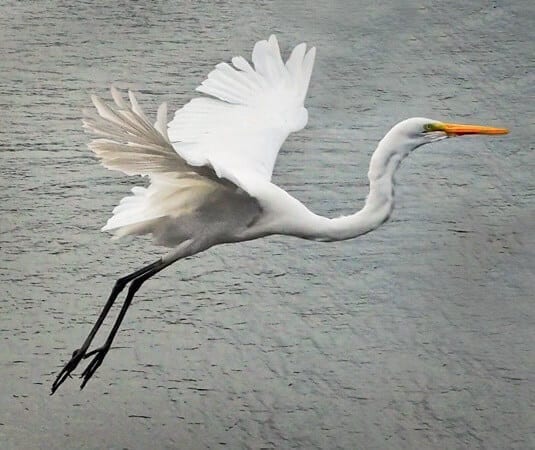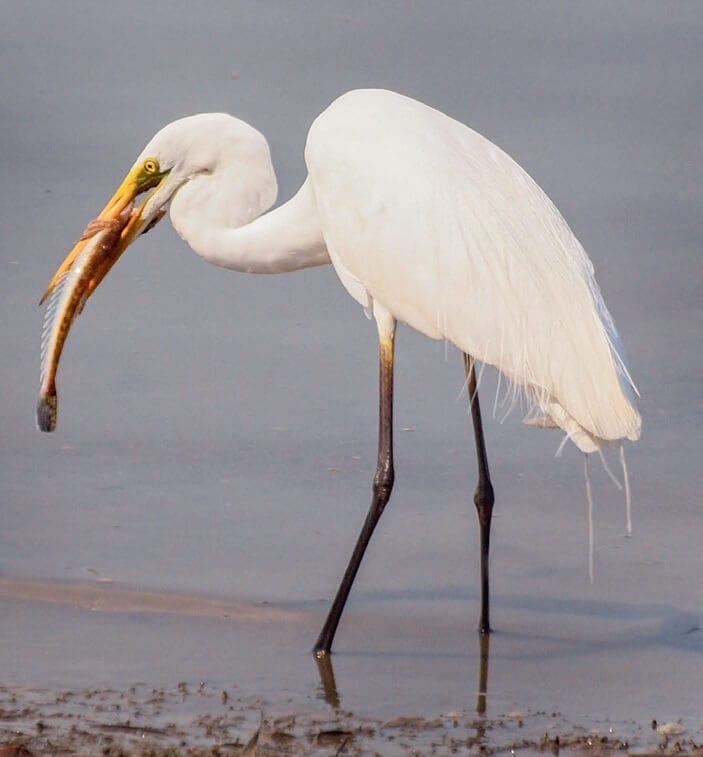Tags: Wildlife. Native. Birds. Egret. Bribie Island. Moreton Bay. Brisbane. Queensland. Australia.
One of the largest and most majestic birds to be found on Bribie Island is the Eastern Great Egret which is commonly found just about anywhere there is shallow water. They are often seen feeding in the passage and shallow, permanent or temporary waterholes. Eastern Great Egrets are the largest of the 5 species of Egrets in Australia being 85-150 cm tall and 600-1200 g in weight.
Featured Image(above): Ready to pounce!
They are tall, elegant and graceful with very long legs and necks and are often seen standing with their necks crooked in the shape of a question mark. Their plumage is all white and in the non-breeding season their bills, facial skin and eyes are yellow. In-flight they are lovely to watch with their necks pulled in, wings flapping slowly, and legs stretched out behind. Male and female are similar with the male being slightly larger. Their call is a deep, guttural croak.
Eastern Great Egrets are found in wetlands or anywhere where the conditions are suitable throughout Australia and in most countries of the world. Their main food is fish, but they also eat frogs, reptiles, crustaceans, and insects. Usually, they feed alone wading slowly through shallow water, poising then spearing their prey with their sharp bill. If a large fish is speared it can be difficult to swallow and usually takes some time before the prey can be consumed. Sometimes other birds take advantage of the situation and pirate the fish before the Egrets can finish their meal.
The breeding season in our area is usually October to December. Great Egrets nest in colonies with other birds such as other species of Egrets, Ibises, Cormorants and Night Herons high up in trees which are in or near water. There is quite a dramatic change in the appearance of the Egrets during the breeding season. Yellow bills turn black, faces become green, legs turn a reddish colour, eyes become red and beautiful white plumes appear on their backs.
Nests are untidy platforms of sticks 50-70 cm in diameter which is lined with grass and close to the top of trees to give easy access to the nest from above. Both parents build the nest, incubate the 2-5 pale blue-green eggs and tend to the chicks. Incubation takes about 25-26 days. After about 60 days the young can fly. During the nesting period, the breeding plumage gradually disappears. One brood is produced per season and the nest is often used again the following year.
It is easy to confuse Eastern Great Egrets with Intermediate Egrets. Great Egrets are larger and the yellow skin on their faces extend past the eye. There are many common names for The Eastern Great Egret such as White Heron, Common Egret and many more. During the 1800s Ostridge feathers along with Egret breeding feathers were much sort after in the fashion world and many populations in the world were entirely wiped out. It wasn’t until the early 1900s when two American women crusaded against this slaughter that the trade of Egret plumes was stopped.
Since that time their numbers have been rejuvenated. An Egret in captivity may live to 22 years whereas their lifespan in the wild is thought to be only 1-3 years. The Chinese Egret symbol represents strength, purity, patience and long life. Conservation status worldwide for the Eastern Great Egret is of least concern for now.




